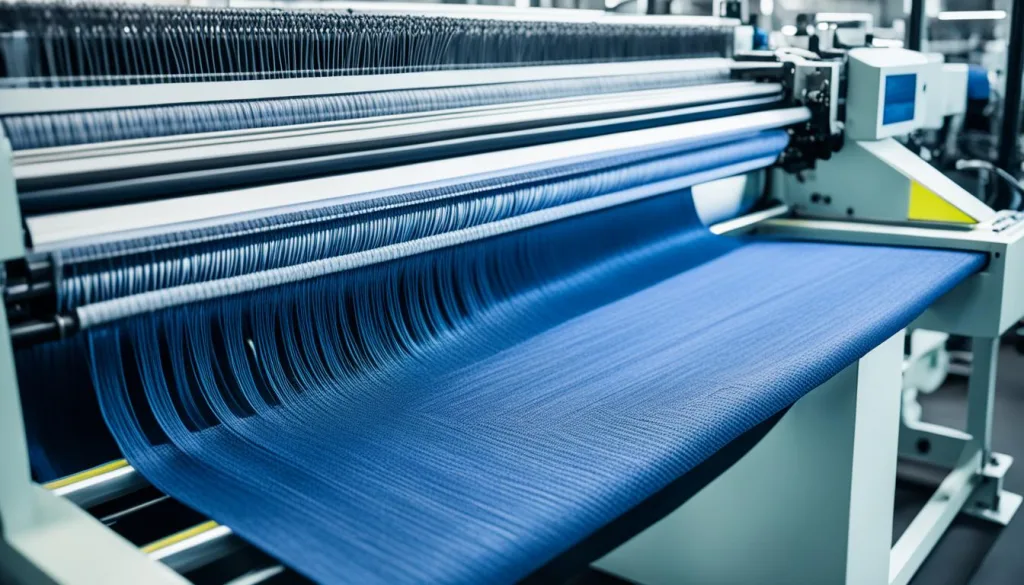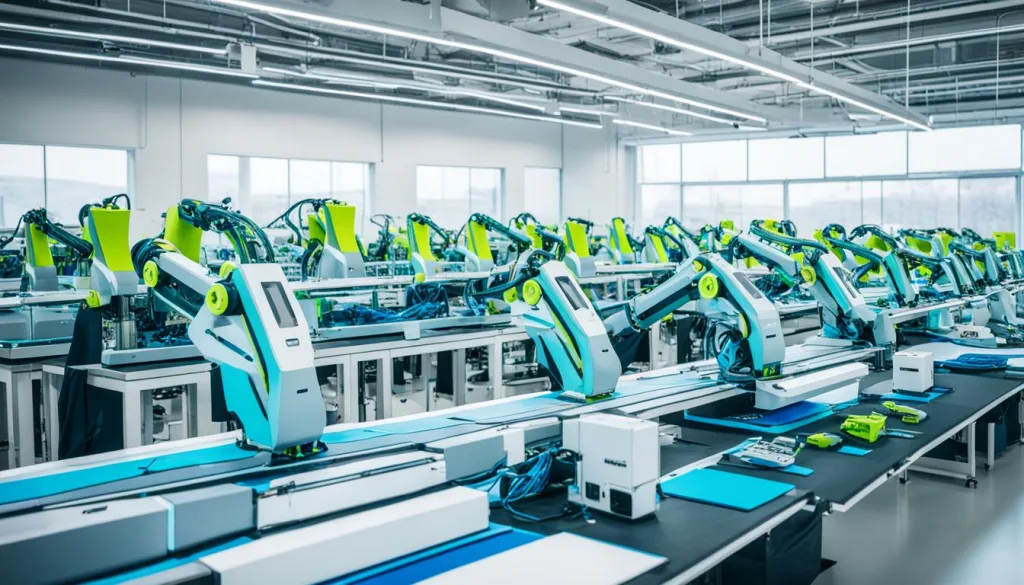How Technology is Supporting Sustainable Sportswear Production
Connect With Us Today
Consider us for your next production run. Why wait? Send us your questions here.
Today, the sustainable sportswear industry is finding new ways to be eco-friendly. They’re using cool tech to make sports clothes that don’t harm the planet. This means when you run or stretch, you’re also doing good for the earth. Tech like RFID and AI helps make eco-friendly athletic wear by cutting down on waste.
This is a big move towards making green sportswear. It’s all about reducing the bad impact on our environment while still giving people the stylish and tough clothes they want12.
Key Takeaways
- Technological innovations are crucial in developing sustainable textile innovations for the sportswear sector.
- Rising demand for sustainable apparel manufacturing is met with tech-driven solutions that cut down on waste and emissions.
- Consumer awareness propels the trend towards eco-friendly athletic wear, influenced by their demand for transparency and sustainability.
- Adoption of advanced technologies like AI aids in the prediction of sales trends, reducing overproduction and fostering circular economy practices in fashion.
- Shifts towards a circular system in the fashion industry represent not just an ethical move, but a significant economic opportunity.
The Role of Technology in Eco-Friendly Athletic Wear Innovation
The sportswear industry is changing, with a big focus on being eco-friendly. Technology is leading this change. Companies like Nike aim to be carbon and waste-free by 2025 using new tech in their clothing3. This is key in reducing the harm that making clothes typically causes. The industry uses 98 million tons of resources and puts out a lot of pollution4. We’ll look at how tech helps make sports clothes better for the planet in this section.
Biotechnology and Natural Fibers
Biotech is changing how we make athletic clothes, using natural materials instead of harmful ones. The fashion world is a big polluter, sending plastic microfibers into the oceans every year from washing clothes4. Biotech finds better options that work well and are better for Earth.
Lab-Grown Materials and Their Impact
Lab-grown materials are a big step towards greener clothes. They use less of Earth’s resources and make less pollution4. This tech helps make less waste and reuse materials. Like Nike, companies are creating new materials and using old ones again to reduce harm to the planet3. This is important for a sustainable future in clothing.
Energy and Water Consumption Tracking Tools
Tools that track energy and water use are crucial for making clothes sustainably. They help brands use fewer resources and cut down on pollution4. Nike, for example, is using these tools to make a difference for the better3. These aren’t just extras; they’re necessary for saving our planet.
This chart shows how traditional and sustainable materials compare. It highlights why we need to switch to eco-friendly options in the clothing industry.
| Material | Lifespan | Decomposition Time | Sustainability Note |
|---|---|---|---|
| Polyester Shirt | Extended | 20 to 200 years | Not sustainable |
| Organic Cotton/TENCEL | Varied | 11 to 27 weeks | Closed-loop production, 99% solvent reuse4 |
| Lab-Grown Materials | Designed for Longevity | Variable | Reduces environmental impact3 |
This picture shows the progress in making sports clothes more eco-friendly. It shows the hard work and smart thinking going into this.

Biotech, lab-grown materials, and smart tracking tools are changing athletic wear for the better. Nike is leading with these eco-friendly ideas3. It’s time to take on the harm from making clothes the old way4. This is a new era for the sportswear industry, moving towards being kinder to our planet.
Technological Advancements in Green Sportswear Production Methods
Eco-friendly production methods are becoming key as more people care about the environment. Sustainable manufacturing techniques are helping brands cut down on pollution. This commitment is shown by using synthetics sourced responsibly and through less harmful processes. Innovative technologies in sportswear manufacturing are changing the game. They’re moving away from traditional polyester to recycled materials56.
The drive for sustainability isn’t just about the environment. It also touches on social and economic matters. Brands like Girlfriend Collective and Patagonia are leading with ethical garment manufacturing processes. They show their dedication with certifications like bluesign and Global Recycled Standards5. These certifications tell shoppers about the brands’ commitment to being green. There’s a growing demand for natural and recycled materials. These are crucial for making sustainable activewear that lessens environmental harm significantly5.

Let’s look at the impact of these green strategies. In 2019, the industry reached a 95% waste diversion rate6. By 2025, they aim to cut water use by 15%6. They’re also setting big goals like being climate neutral by 2025.6 They want to lower GHG emissions by 30% across the value chain by 20306. Upgrading wastewater plants at suppliers is key. This aims to meet the ZDHC ‘Wastewater Foundational Level’, showing serious water management efforts6.
The success of sustainability efforts is clear. For example, in 2022, 96% of the polyester used was recycled6. This is part of a bigger goal to use only recycled polyester. The developments in product design also shine through. Take the Adizero Lightstrike and Supernova 2 shoes. They have a much lower carbon footprint than earlier models. This proves that technological advancements can blend sustainability with top performance6.
“Sustainable fashion considers not only the environmental but also the social and economic impacts of production and consumption.”
Today, we need a full view of sustainability that goes beyond materials. We suggest people audit their clothes, buy less new stuff, and choose pre-owned garments when they can. By doing this and supporting the industry’s shift toward sustainable manufacturing techniques, we create a future where fashion is conscious, innovative, and kind to our planet5.
Sustainable Apparel Manufacturing: From 3D Design to AI
The fashion world is changing because of new tech and a focus on the environment. Companies now use things like 3D design and AI to make clothes in a better way. This helps deal with old problems in making clothes.
3D Modeling for Waste Reduction
Walmart is trying something new with 3D design to cut waste. They work with Unspun to make clothes from yarn, without losing fabric or having too much stock. This 3D weaving machine could really change the clothing industry7.
They also want to make more clothes in the U.S. and keep the environment safe7. With Unspun’s new factory in Oakland, they’re making eco-friendly ways to make clothes7.
AI-Powered Trend Analysis for Demand Forecasting
AI trend analysis is also improving. It looks at lots of data to predict what clothes people will want. This helps avoid making too many clothes, which is good for the planet.
Machine Learning to Optimize Production Cycles
Machine learning helps make making clothes faster and smarter. Unspun uses it to make clothes in days instead of months8. This makes customers happy and helps the planet by using less resources.
Adding machine learning also speeds up making clothes. It helps make only what’s sold, reducing waste8.
Technologies like these change how Walmart and others sell clothes7. They’re thinking about what’s good for the Earth and what customers want. This is the future of making clothes in a smart and kind way.
As companies mix tech with caring for the planet, the way we make clothes will keep getting better. This means companies might have to follow stricter rules to protect the environment8.
Sustainable Textile Innovations Pioneered by Technology
Technology and sustainability are merging to bring a new phase to fashion, especially in sportswear. The fashion industry’s carbon footprint and waste are huge, with 10% of global CO2 emissions and 92 million tons of waste each year. There’s a big push for eco-friendlier fabrics, aiming to cut down waste and greenhouse gases9. These innovations are also meeting the growing demand for sustainable clothes, expected to increase significantly by 20269.
Places like De Montfort University (DMU) are at the forefront of sustainable textile innovations. Their Textile Design, Technology and Innovation course prepares students with the knowledge and hands-on skills for the future’s textile industry. DMU alumni are finding success in various eco-conscious roles at top companies10. They get real-world experience through a year-long work placement, blending education with practical industry experience10.
Efforts to make fashion greener also include adopting new technologies in textiles, driven by evolving laws. Upcoming policies and initiatives are supporting sustainable and circular tech innovations. This means the future of eco-friendly sportswear will combine education, policy, and advanced technology. It’s all about creating a better future for our planet through smarter fashion solutions.
FAQ
How is technology supporting sustainable sportswear production?
What is the role of biotechnology and natural fibers in sustainable sportswear production?
How do lab-grown materials impact the eco-friendly fashion industry?
What is the importance of energy and water consumption tracking tools in sportswear production?
What are the technological advancements in green sportswear production methods?
How does 3D design contribute to waste reduction in sustainable apparel manufacturing?
How is AI-powered trend analysis revolutionizing the production of sustainable sportswear?
How does machine learning optimize production cycles in sustainable sportswear manufacturing?
What are the sustainable textile innovations pioneered by technology?
Source Links
- https://www.ellenmacarthurfoundation.org/fashion-and-the-circular-economy-deep-dive
- https://www.forbes.com/sites/forbestechcouncil/2022/01/31/sustainability-in-fast-fashion-how-tech-can-minimize-waste/
- https://www.nike.com/sustainability
- https://www.shape.com/fitness/clothes/how-to-shop-for-sustainable-activewear
- https://www.cnn.com/cnn-underscored/fashion/best-sustainable-activewear-brands
- https://report.adidas-group.com/2022/en/group-management-report-our-company/sustainability/environmental-impacts.html
- https://www.manufacturingdive.com/news/walmart-pilots-3d-weaving-machines-unspun/710873/
- https://www.businessinsider.com/3d-printed-clothing-weaving-fashion-industry-sustainability-zero-waste-2023-10
- https://www.theinterline.com/2023/11/28/digital-transformation-the-solution-to-sustainable-fashion/
- https://www.dmu.ac.uk/study/courses/postgraduate-courses/sustainable-textile-technologies-degree/sustainable-textile-technologies-degree.aspx
Latest News
How Collaboration Shapes Consumer Preferences in Sportswear
Navigating Consumer Rights and Warranties in Sportswear Sales
Artificial Intelligence in Fashion Forecasting and Trend Analysis
The Shift Towards Inclusive Sizing in Sportswear: Consumer Reactions
The Global Expansion of Luxury Sportswear Brands
From Sketch to Gym: The Design Process of Fashionable Sportswear
Understanding the Role of Trade Associations in Sportswear Compliance
How Economic Trends Influence Consumer Spending on Sportswear
Learning from Successful Global Market Entries
Best Practices for Managing Cross-Cultural Teams
Using Technology to Fight Counterfeit Fashion Products
Carbon Nanotube Fabrics for Superior Strength and Flexibility
The Growth of Fitness Tracking Apparel in Health and Wellness
Exploring the Influence of Social Proof in Sportswear Purchasing
Strategies for Managing Compliance in a Multinational Operation
Trends in Global Footwear: Performance Meets Lifestyle
The Role of Artificial Intelligence in Tracking Supply Chain Operations
Evaluating the Success of Sportswear Collaborative Projects
Evaluating the Potential of Emerging Markets
Global Shifts Towards Gender-Neutral Sportswear
Share This Article
Latest Articles



















